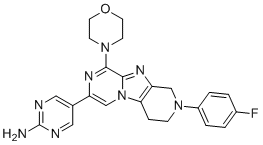
PI3K-IN-8q
CAS No. 1280204-67-2
PI3K-IN-8q ( —— )
Catalog No. M11155 CAS No. 1280204-67-2
PI3K-IN-8q is a potent, selective dual p110α/p110δ inhibitor with Ki app of 3.3/8.36 nM respectively.
Purity : >98% (HPLC)
 COA
COA
 Datasheet
Datasheet
 HNMR
HNMR
 HPLC
HPLC
 MSDS
MSDS
 Handing Instructions
Handing Instructions
| Size | Price / USD | Stock | Quantity |
| 100MG | Get Quote | Get Quote |


|
| 200MG | Get Quote | Get Quote |


|
| 500MG | Get Quote | Get Quote |


|
| 1G | Get Quote | Get Quote |


|
Biological Information
-
Product NamePI3K-IN-8q
-
NoteResearch use only, not for human use.
-
Brief DescriptionPI3K-IN-8q is a potent, selective dual p110α/p110δ inhibitor with Ki app of 3.3/8.36 nM respectively.
-
DescriptionPI3K-IN-8q is a potent, selective dual p110α/p110δ inhibitor with Ki app of 3.3/8.36 nM respectively; exhibits high selectivity over p110α and p110β (Ki>490 nM); inhibits p-Akt with EC50 of 50 nM, and p110α with IC50 of 0.5 nM; has promising in vivo PK data; orally bioavailable.
-
Synonyms——
-
PathwayPI3K/Akt/mTOR signaling
-
TargetPI3K
-
RecptorPI3K
-
Research Area——
-
Indication——
Chemical Information
-
CAS Number1280204-67-2
-
Formula Weight446.49
-
Molecular FormulaC23H23FN8O
-
Purity>98% (HPLC)
-
Solubility——
-
SMILES——
-
Chemical Name5-(2-(4-fluorophenyl)-9-morpholino-1,2,3,4-tetrahydropyrido[3',4':4,5]imidazo[1,2-a]pyrazin-7-yl)pyrimidin-2-amine
Shipping & Storage Information
-
Storage(-20℃)
-
ShippingWith Ice Pack
-
Stability≥ 2 years
Reference
1. Martínez González S, et al. Bioorg Med Chem Lett. 2017 Jun 1;27(11):2536-2543.
molnova catalog


related products
-
GDC-0077
GDC-0077 (RG-6114) is a potent, highly isoform selective inhibitor of PI3Kα, with IC50 of 0.038 nM.
-
ON 146040
ON 146040 is an effective inhibitor of PI3K isoforms with IC50s of 14 and 20 nM for PI3Kα and PI3Kδ, respectively.
-
PQR309
PQR309 (Bimiralisib) is a potent, brain-penetrant, orally bioavailable, pan-class I PI3K/mTOR inhibitor with IC50 of 33, 451, 661, 708 and 89 nM for PI3Kα, PI3Kδ, PI3Kβ, PI3Kγ and mTOR, respectively.



 Cart
Cart
 sales@molnova.com
sales@molnova.com


